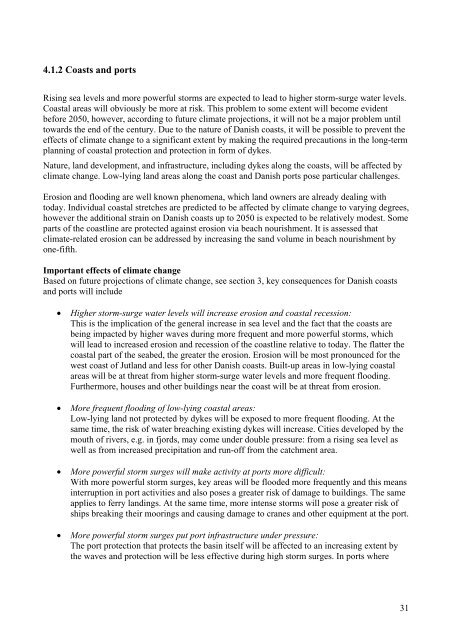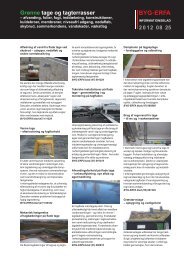Mapping climate change - barriers and opportunities for action
Mapping climate change - barriers and opportunities for action
Mapping climate change - barriers and opportunities for action
Create successful ePaper yourself
Turn your PDF publications into a flip-book with our unique Google optimized e-Paper software.
4.1.2 Coasts <strong>and</strong> ports<br />
Rising sea levels <strong>and</strong> more powerful storms are expected to lead to higher storm-surge water levels.<br />
Coastal areas will obviously be more at risk. This problem to some extent will become evident<br />
be<strong>for</strong>e 2050, however, according to future <strong>climate</strong> projections, it will not be a major problem until<br />
towards the end of the century. Due to the nature of Danish coasts, it will be possible to prevent the<br />
effects of <strong>climate</strong> <strong>change</strong> to a significant extent by making the required precautions in the long-term<br />
planning of coastal protection <strong>and</strong> protection in <strong>for</strong>m of dykes.<br />
Nature, l<strong>and</strong> development, <strong>and</strong> infrastructure, including dykes along the coasts, will be affected by<br />
<strong>climate</strong> <strong>change</strong>. Low-lying l<strong>and</strong> areas along the coast <strong>and</strong> Danish ports pose particular challenges.<br />
Erosion <strong>and</strong> flooding are well known phenomena, which l<strong>and</strong> owners are already dealing with<br />
today. Individual coastal stretches are predicted to be affected by <strong>climate</strong> <strong>change</strong> to varying degrees,<br />
however the additional strain on Danish coasts up to 2050 is expected to be relatively modest. Some<br />
parts of the coastline are protected against erosion via beach nourishment. It is assessed that<br />
<strong>climate</strong>-related erosion can be addressed by increasing the s<strong>and</strong> volume in beach nourishment by<br />
one-fifth.<br />
Important effects of <strong>climate</strong> <strong>change</strong><br />
Based on future projections of <strong>climate</strong> <strong>change</strong>, see section 3, key consequences <strong>for</strong> Danish coasts<br />
<strong>and</strong> ports will include<br />
<br />
<br />
<br />
<br />
Higher storm-surge water levels will increase erosion <strong>and</strong> coastal recession:<br />
This is the implication of the general increase in sea level <strong>and</strong> the fact that the coasts are<br />
being impacted by higher waves during more frequent <strong>and</strong> more powerful storms, which<br />
will lead to increased erosion <strong>and</strong> recession of the coastline relative to today. The flatter the<br />
coastal part of the seabed, the greater the erosion. Erosion will be most pronounced <strong>for</strong> the<br />
west coast of Jutl<strong>and</strong> <strong>and</strong> less <strong>for</strong> other Danish coasts. Built-up areas in low-lying coastal<br />
areas will be at threat from higher storm-surge water levels <strong>and</strong> more frequent flooding.<br />
Furthermore, houses <strong>and</strong> other buildings near the coast will be at threat from erosion.<br />
More frequent flooding of low-lying coastal areas:<br />
Low-lying l<strong>and</strong> not protected by dykes will be exposed to more frequent flooding. At the<br />
same time, the risk of water breaching existing dykes will increase. Cities developed by the<br />
mouth of rivers, e.g. in fjords, may come under double pressure: from a rising sea level as<br />
well as from increased precipitation <strong>and</strong> run-off from the catchment area.<br />
More powerful storm surges will make activity at ports more difficult:<br />
With more powerful storm surges, key areas will be flooded more frequently <strong>and</strong> this means<br />
interruption in port activities <strong>and</strong> also poses a greater risk of damage to buildings. The same<br />
applies to ferry l<strong>and</strong>ings. At the same time, more intense storms will pose a greater risk of<br />
ships breaking their moorings <strong>and</strong> causing damage to cranes <strong>and</strong> other equipment at the port.<br />
More powerful storm surges put port infrastructure under pressure:<br />
The port protection that protects the basin itself will be affected to an increasing extent by<br />
the waves <strong>and</strong> protection will be less effective during high storm surges. In ports where<br />
31

















